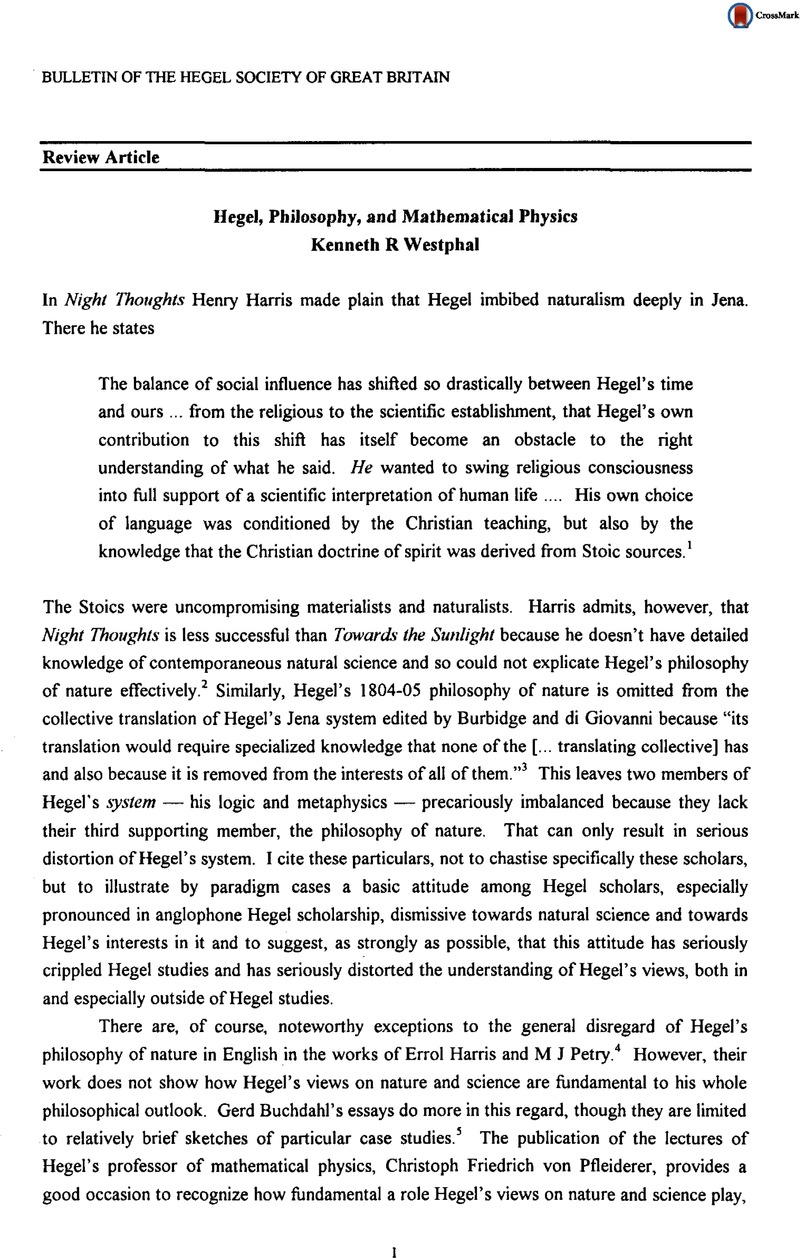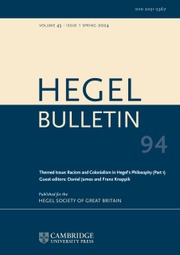Article contents
Hegel, Philosophy, and Mathematical Physics
Published online by Cambridge University Press: 23 June 2015
Abstract

- Type
- Review Article
- Information
- Bulletin of the Hegel Society of Great Britain , Volume 18 , Issue 2: number 36 , Autumn/Winter 1997 , pp. 1 - 15
- Copyright
- Copyright © The Hegel Society of Great Britain 1997
References
1 Harris, H S, Hegel's Development: Night noughts (Jena 1801-1806) (Oxford: Clarendon Press, 1983), p 302 CrossRefGoogle Scholar.
2 Harris, H S, “Philosophy and Life” (Clio, 1998, ms. p. 8)Google Scholar.
3 Hegel, G W F, The Jena System, 1804-5: Logic and Metaphysics; Burbidge, J W & di Giovanni, G, eds. (Kingston & Montreal: McGill-Queen's University Press, 1986), vii–viii CrossRefGoogle Scholar.
4 Harris, Errol E, Nature, Mind and Modern Science (London: George Allen & Unwin; New York: Humanities, 1954)Google Scholar, Hypothesis and Perception (London: George Allen & Unwin; New York: Humanities, 1970)Google Scholar; Petry, M J, ed, Hegel and Newtonianism (Dordrecht & Boston: Kluwer, 1993)CrossRefGoogle Scholar, and Petry's extensive and invaluable notes to his translation and edition of Hegel's Philosophy of Nature (3 vols; London, George Allen and Unwin; New York: Humanities, 1970)Google Scholar.
5 Buchdahl, Gerd, “Hegel's Philosophy of Nature and the Structure of Science” (Ratio 15 No 1, 1973 Google Scholar; rpt in: Inwood, M., ed, Hegel; Oxford: Oxford University Press, 1985, 110–136)Google Scholar, “Conceptual Analysis and Scientific Theory in Hegel's Philosophy of Nature (with Special Reference to Hegel's Optics)” (in: Cohen, R S and Wartofsky, M, eds, Hegel and the Sciences; Dordrecht: Reidel, 1984; 13–36)CrossRefGoogle Scholar, “Hegel's Philosophy of Nature” (British Journal for the Philosophy of Science 23, 1972, 257–266)CrossRefGoogle Scholar; cf. “History of Science and Criteria of Choice” (in: Stuewer, R., ed, Historical and Philosophical Perspectives of Science; Minnesota Studies in the Philosophy of Science 5, 1970, 204–30)Google Scholar, and “Neo-transcendental Approaches Towards Scientific Theory Appraisal” (in: Mellor, D. H., ed, Science, Belief and Behaviour; Cambridge: Cambridge University Press, 1980; 1–20 Google Scholar).
6 von Pfleiderer, Christoph Friedrich, Physik. Naturlehre nach Klügel. Nachschrift einer Tübinger Vorlesung von 1804 Google Scholar. Herausgegeben und mit einer Einleitung versehen von Paul Ziche. Spekulation und Erfahrung. Abt I, Bd 6. Stuttgart-Bad Cannstatt: frommann-holzboog, 1994, 525 pp, Hb DM228.
7 In Toward the Sunlight (Oxford: Clarendon Press, 1972)Google Scholar Harris states: “… C F Pfleiderer, professor of mathematics and physics, was a mathematician of some worth, whose principal interest was in analytical geometry. Betzendörfer says that he was an admirer of the Greek mathematicians. Hegel would have appreciated him for both of these reasons, but his interest in mathematics and physics remained largely extraneous to his more philosophical concerns for more than a decade still to come, so the question of Pfleiderer's possible influence upon him can scarcely concern us here” (p 81). Unfortunately, when Harris turns to that later period in Night Thoughts, he doesn't discuss Pfleiderer or his possible influence on Hegel.
8 Ziche's Introduction fills the first 56 pages; §§I-III concern Pfleiderer's training, research, and teaching; §IV (pp 32-35) sketches his influence, especially on Hegel, and includes references to Wolfgang Neuser's very useful work on Hegel's Dissertatio and library holdings in the natural sciences. (But also see Neuser's book, Natur und Begriff. Studien zur Theorienkonstitution und Begriffsgeschichte von Newton bis Hegel; Stuttgart: Metzler, 1995.Google Scholar) In his review of Pfleiderer's Physik M J Petty reviews and augments this information (Owl of Minerva 27 No 2, 1996, pp 185-91). Hence I do not discuss it here.
9 In his review, Petry appears to concur (op cit, p 187).
10 Briefe von und an Hegel (4 vols, Hoffmeister, J, ed; Hamburg: Meiner, 1952), IV. 1, pp 23–24 Google Scholar.
11 See de Vincentis, Mauro Nasti, “Hegel's Worm in Newton's Apple” (in: Houlgate, S., ed, Hegel and the Philosophy of Nature (Albany: State University of New York Press, 1997)Google Scholar.
12 I sketch Hegel's epistemology in detail in Hegel's Epistemological Realism (Dordrecht: Kluwer, 1989)Google Scholar; abbreviated “HER”), ch. 11; a synopsis appears in “Hegel” (in Sosa, E & Dancy, J, eds, A Companion to Epistemology; Oxford: Blackwell, 1992; 167–70)Google Scholar. In Hegel's Ladder (2 vols, Indianapolis: Hackett, 1997 Google Scholar; abbreviated “HL”), Henry Harris independently comes to much the same view of Hegel's epistemology. I summarize his view of Hegel's epistemology in “Harris, Hegel, and the Spirit of the Phenomenology” (Clio, 1998), §5.
13 I reconstruct Hegel's early arguments for these conclusions in “Kant, Hegel, and the Transcendental Material Conditions of Possible Experience,” Bulletin of the Hegel Society of Great Britain 33 (1996), pp 23–41 Google Scholar.
14 See my essay, “On Hegel's Early Critique of Kant's Metaphysical Foundations of Natural Science” (in Houlgate, ed, op cit).
15 See Petry's suggestion in his review (op cit, pp 190-91).
16 See my “Kant's Dynamic Constructions” (Journal of Philosophical Research 20, 1995, pp 381–429), §VCrossRefGoogle Scholar.
17 Pfleiderer's own heavily annotated copy of Karsten's text is extant in the Tübinger Universitätsbibliothek (Signatur: Be 176) (p 24 note 50).
18 See HER pp 160-71. I develop this argument in detail, though independently of Hegel, , in “Transcendental Reflections on Pragmatic Realism” (in: Westphal, K R, ed, Pragmatism, Reason, & Norms: A Realistic Assessment; New York: Fordham University Press, 1997; pp 15–53)Google Scholar.
19 See HER pp 159-60 and ch. 10.
20 HL II, p 355.
21 See my essay, “Kant's Proof of the Law of Inertia” (in: Robinson, H, ed, Proceedings of the 8th International Kant Congress; Milwaukee: Marquette University Press, 1995; III, pp 413–24Google Scholar).
22 See the excellent discussion of this point by François De Gandt in the Conclusions to his Force and Geometry in Newton's Principia (Wilson, Curtis, trans Princeton: Princeton University Press, 1995)Google Scholar.
23 For a concise statement, see Buchdahl's “Neo-Transcendental Approaches …” (op cit.). Buchdahl claims to derive this view from Kant, though he recognizes that it fits Hegel's view of science, too (see the articles cited above). I have argued elsewhere that Buchdahl's view does not in fact match Kant's (“Buchdahl's ‘Phenomenological’ View of Kant: A Critique,” Kant-Studien, forthcoming).
24 Here I follow de Gandt's perspicacious analysis.
25 See de Gandt, op cit., pp 80-81, 63-74.
26 See de Gandt, op cit., pp 248-49, 263-64.
27 De Gandt, op cit., pp 249, 285 note 32.
28 De Gandt's detailed guide to Newton's mathematical methods is invaluable, and a delight to read.
29 Cf Hume, Enquiry Concerning Human Understanding §VII Part I, final note (on vis inertiae and gravity).
30 See HER pp 160, 273 note 29.
31 For discussion of the chemical revolution in connection with Kant, see Friedman, Michael, Kant and the Exact Sciences (Cambridge, Mass.: Harvard University Press, 1992), pp 264–90Google Scholar.
32 See Koyré, Alexandre, “Newton and Descartes,” (in Newtonian Studies; London: Chapman & Hall, 1965), pp 149–63 (but cf. 110)CrossRefGoogle Scholar, and Hall, Rupert and Hall, Marie B, “Newton's Theory of Matter,” Isis 51, 1960, pp 131–44CrossRefGoogle Scholar.
33 Newton, , Opticks (New York: Dover, 1952), pp 389, 400 Google Scholar; and Hall, A R and Hall, M B, eds and trs, Unpublished Scientific Papers of Isaac Newton (Cambridge: Cambridge University Press, 1962), p 106 Google Scholar; Descartes, , The Philosophical Writings of Descartes (Cottingham, J, Stoothoff, R, & Murdoch, D, trs; Cambridge: Cambridge University Press, 1984-), III pp 361, 372 Google Scholar. On Newton's corpuscularism, see Mandelbaum, Maurice, Philosophy, Science, and Sense Perception (Baltimore: Johns Hopkins University Press, 1964), pp 66–88 CrossRefGoogle Scholar; Newton's corpuscularism allowed for voids within material bodies (Opticks, pp 389-90, 400), and he and his followers opposed Descartes's material plenum (Koyré, op cit, p 61); on Descartes' material plenum, see Garber, Daniel, Descartes' Metaphysical Physics, (Chicago: University of Chicago Press, 1992), pp 130–36Google Scholar.
34 For discussion, see Buchdahl, “Hegel's Conception of ‘Begriffsbestimmung’ …” (op cit) and “Conceptual Analysis and Scientific Theory …” (op cit, pp 18-25). Buchdahl recognizes Hegel's “Aristotelianism” (“Hegel's Philosophy of Nature,” op cit, pp 260-61), but never quite brings it into focus along with Hegel's preference for “phenomenological” laws of nature. This is because Buchdahl doesn't quite see Hegel's enriched account of “phenomenological” laws which I try to bring out here.
35 Phänomenologie des Geistes (abbreviated “PhdG”) ( Buchner, H & Pöggeler, O, eds, Gesammelte Werke; Hamburg: Meiner, 1968 Google Scholar; abbreviated “GW”; vol. IX), p 91.31-37/ Miller, A V, tr, Hegel's Phenomenology of Spirit (Oxford: Clarendon Press: 1977), p 91 Google Scholar.
36 PhdG p 92.10-19/Miller, p 91.
37 PhdG p 92.23-26/Miller, p 91.
38 PhdG pp 93.7-94. 28/Miller, pp 92-93.
39 PhdG p 95.12-13/Miller, p 95; original emphasis.
40 PhdG pp 94.35-95.24/Miller, pp 94-95.
41 De Gandt, op cit, p 267.
42 See Will, Frederick L, Pragmatism and Realism (Lanham, Md: Rowman & Littlefield, 1997)Google Scholar.
43 On these, see the very helpful articles by Wolff, Michael, “Hegel und Cauchy. Eine Untersuchung zur Philosophie und Geschichte der Mathematik” (in Horstmann, R-P, ed, Hegel und die Naturwissenschaften; Stuttgart-Bad Cannstatt: frommannholzboog, 1987; pp 197–263)Google Scholar and Stekeler-Weithofer, Pirmin, “Hegels Philosophie der Mathematik” (in Demmerling, C & Kambartel, F, eds, Vernunftkritik nach Hegel; Frankfurt/Main: Suhrkamp, 1992; pp 214–49Google Scholar).
44 Ziche took pains to correct some errors in Pfleiderer's proofs, but read them carefully. On the third line from the bottom of p 118, “CL = LD” should read “CL = CD.” Recall that “C” stands for “celeritas” or speed (not velocity, which is a vector quantity). Also note that sign used on the top of p 79 (and a few times thereafter) can be understood in terms of Euclid V.S, which is cited in this connection. Anyone interested in the history of mathematics should know of Cajori, Florian, A History of Mathematical Notations (Chicago: Open Court, 1929)Google Scholar.
45 On this loss, see the editor's explanation in GW III, pp 301-03.
- 2
- Cited by




